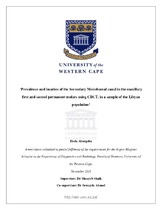| dc.contributor.advisor | Shaik, Shoayeb | |
| dc.contributor.author | Aburgeba, Hoda | |
| dc.date.accessioned | 2022-03-01T07:17:42Z | |
| dc.date.available | 2022-03-01T07:17:42Z | |
| dc.date.issued | 2021 | |
| dc.identifier.uri | http://hdl.handle.net/11394/8758 | |
| dc.description | Magister Scientiae Dentium - MSc(Dent) | en_US |
| dc.description.abstract | Previously, many studies have used cone beam computed tomography (CBCT) to
detect and confirm the exact location of the MB2 canal in maxillary molars. It is now considered
the gold standard, as it allows clinicians to visualize complex anatomical structures and to perform
endodontic treatment safely. However, in the context of this study, the prevalence and location of
the MB2 in maxillary first and second permanent molars among the Libyan population is limited.
The aim of this in vivo study is to describe the prevalence and location of the MB2 in the
mesiobuccal root of first and second maxillary molars and to describe a methodology to enable its
geometric location in the Libyan population using CBCT imaging. | en_US |
| dc.language.iso | en | en_US |
| dc.publisher | University of Western Cape | en_US |
| dc.subject | Mesiobuccal canal | en_US |
| dc.subject | Libyan population | en_US |
| dc.subject | Maxillary molars | en_US |
| dc.subject | Cone beam computed tomography (CBCT) | en_US |
| dc.title | Prevalence and location of the secondary mesiobuccal canal in the maxillary first and second permanent molars using cbct; In a sample of the Libyan population’ | en_US |
| dc.rights.holder | University of Western Cape | en_US |

